Automatic High Beam
The Automatic High Beam system uses a sophisticated front camera, positioned on the upper part of the windshield, to continuously assess the brightness from oncoming vehicles, streetlights, and other light sources. Based on these observations, the system intelligently toggles between high beams and low beams to optimize visibility while minimizing glare for other road users.
WARNING
For Safe Use
Do not rely exclusively on the Automatic High Beam function. It is crucial to remain alert, actively monitor your surroundings, and manually adjust your headlight settings if necessary, ensuring that you maintain full control over your driving conditions.
Preventing Unintentional Operation
Additionally, this feature not only enhances nighttime visibility but also contributes to safer driving by adapting to rapidly changing external conditions. By automatically adjusting the headlight beams, it reduces driver fatigue and ensures optimal road illumination under varying circumstances.
This state-of-the-art system is an excellent example of modern automotive technology, as demonstrated by one innovative Toyota model.
Using the Automatic High Beam System
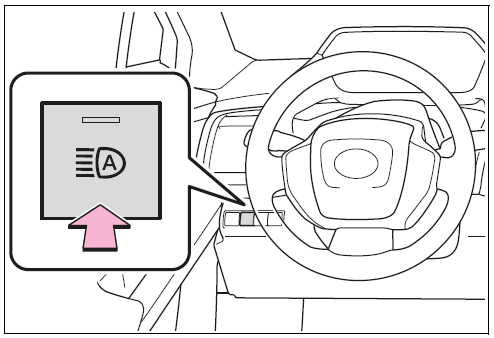
 or
or
 position.
position.
When the headlight switch lever is in the low beam position, the AHB system will be enabled and the AHB indicator will illuminate.
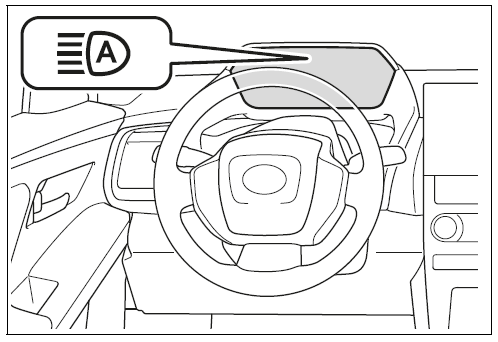
The automatic high beam function dynamically adjusts your headlights by switching between high and low beams based on ambient light conditions detected by a front-mounted camera. When all of the criteria below are fulfilled, the high beams will illuminate automatically:
Conversely, the headlights will revert to low beams if any of the following conditions are met:
The front camera is integral to the system’s performance, yet certain conditions may prevent it from accurately switching the high beams to low beams. For example, the high beams may not automatically change if:
Additionally, if a vehicle ahead is using fog lights without its main headlights on, or if nearby house lights, streetlights, traffic signals, and illuminated billboards dominate the scene, the system may either switch to low beams or leave the low beams activated. Factors such as the brightness, movement, direction, and distance of vehicles ahead; the illumination on only one side; the presence of two-wheeled vehicles; road gradient and curvature; as well as the load in the vehicle-all can influence the timing of beam changes.
In some scenarios, the headlights might alternate between high and low beams unexpectedly, especially if the sensors detect ambient lighting similar in appearance to headlights or tail lights. Moreover, bicycles and other small vehicles might not be fully detected, compromising the sensor’s ability to measure brightness accurately. When the ambient conditions-such as dirty or misaligned head/tail lights, or rapidly fluctuating light sources-cause the system to misread the environment, manual control becomes essential to prevent dazzling oncoming traffic or pedestrians.
Enhancing Visibility and SafetyThis advanced automatic high beam system is engineered to boost nighttime visibility while reducing driver fatigue, as it automatically adjusts the headlight intensity in response to changing road conditions. Regular maintenance and calibration of the sensor are critical, especially in adverse weather conditions or if obstructions like dirt or stickers block the sensor’s view.
For enhanced road safety and improved driver comfort, advanced technologies such as this not only heighten visibility but also contribute to overall energy efficiency by adapting light output to actual needs. For instance, one prominent Toyota model integrates this system to optimize headlight performance in real time.
By understanding these operating conditions and remaining prepared to override the system manually when necessary, you can ensure that the automatic high beam function works as intended. This ensures a safer driving experience, minimizes glare for other motorists, and ultimately contributes to a more secure and energy-efficient journey.
Temporarily reducing front camera sensitivity
The sensitivity of the front camera can be temporarily reduced.
 or
or
 position.
position.
When you need to override the automatic headlight control for more precise illumination, manually operating the high beams is simple and effective.
Switching to High Beams
To activate the high beams manually, push the control lever forward. As you do so, the Automatic High Beam (AHB) indicator will turn off and the high beam indicator will light up, confirming that the headlights are now in high beam mode.
When you are ready to revert to the automatic system, pull the lever back to its original position. This action re-enables the Automatic High Beam system, which will resume adjusting the light output based on ambient conditions.
This manual override is especially useful when driving in dynamic environments where immediate changes in light intensity are required-for example, on dark rural roads or at unfamiliar intersections. By allowing you to control whether to use high or low beams, the system enhances nighttime visibility, driver safety, and overall driving comfort.
Advanced vehicle technology integrates this feature to ensure that headlight settings adapt quickly to both driver input and changing environmental conditions. With this capability, you secure optimal road illumination and energy efficiency, making every journey safe and well-lit.
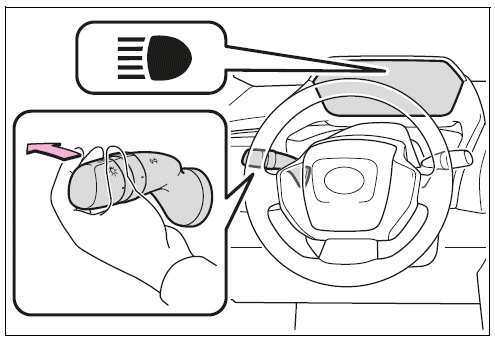
To switch to low beams from an active high beam setting, simply press the Automatic High Beam switch. This action will deactivate the AHB indicator, clearly indicating that the high beam mode has been turned off.
Once the switch is pressed, the headlights revert to low beam mode. If you wish to re-enable the Automatic High Beam system, press the same switch again to trigger the system's automatic adjustments based on ambient light.
This feature allows you to quickly adjust your headlights manually for improved safety and comfort, particularly in complex driving environments where full high beams may not be appropriate. In situations such as approaching oncoming traffic or sudden changes in weather conditions, a swift change to low beams can help minimize glare while maintaining clear visibility.
Modern vehicles incorporate these intelligent headlight controls to ensure you have optimal flexibility in managing road illumination. For instance, one advanced Toyota model blends such features with sensor-driven automation, allowing for smooth transitions between high and low beams that not only enhance driving safety but also energy efficiency.
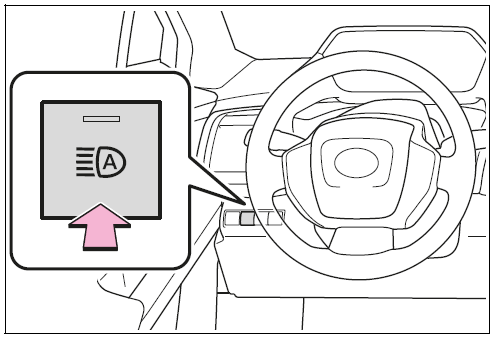
When conditions make the use of high beams inappropriate-for example, when approaching oncoming traffic, pedestrians, or other road users-it is advisable to switch temporarily to low beams.
To do this, pull the headlight control lever rearward, then return it to its original position. While you pull the lever, the high beams remain illuminated, ensuring that you maintain sufficient illumination. Once the lever is released, the system automatically switches to low beams for a preset period.
This temporary adjustment minimizes glare and prevents discomfort for nearby drivers and pedestrians, yet still provides ample light for safe navigation. After the low beam phase, the Automatic High Beam system resumes control, dynamically adapting the headlights to match the ambient conditions.
This flexible functionality enhances both safety and driving comfort. Advanced headlight systems, like the one used in a prominent Toyota model, integrate this feature to provide smooth transitions and optimal roadway illumination tailored to various driving scenarios.
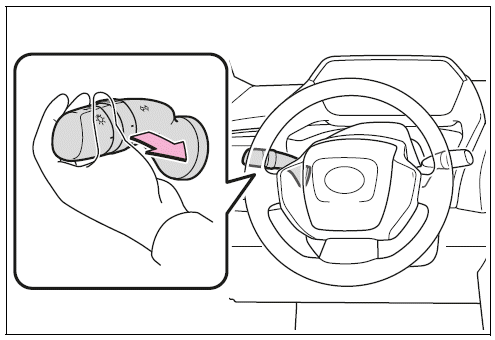
 Operating the lights and wipers
Operating the lights and wipers Windshield Wipers and Washer
Windshield Wipers and WasherEmergency assistance
System Components: Safety Connect in Your Toyota bZ4X
Safety Connect is an advanced subscription-based telematics service that enhances safety and security in select Toyota vehicles equipped with compatible hardware. Utilizing Global Positioning System (GPS) data and embedded cellular technolog ...
Driving procedures
Efficient and confident operation of your Toyota bZ4X electric SUV begins with mastering the fundamental driving procedures. Familiarizing yourself with essential components, such as the Power (Ignition) Switch, enables you to seamlessly activate the EV system and take full advantage of your vehicle ...